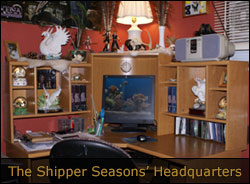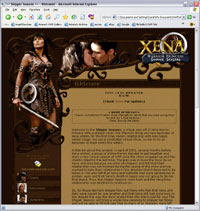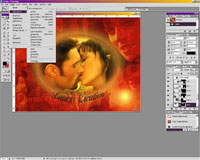|
|
|
|
|

|
|
The below was written around 2006, I believe, so some things may be quite out of date (especially the 10+ year old photo of my room). Still, you can see a bit about the process I went through back in the day, some of which (including writing, collage creation and coding) has not changed much. Enjoy the trip down memory lane--I know I have!

You may not realize it and may sometimes take what we do here for granted, but it takes a lot of work to produce the Shipper Seasons. We may not have to deal with casting, cameramen, and worrying about budgets and ratings as the creators of Xena did, but we still have a lot of work to do. All of us here volunteer our time to create episodes and we may spend many hours a week working on some aspect of the Shipper Seasons in order to bring you new episodes.
Each person here helps immensely and without the help from many people, this place probably wouldn't exist. There is no way one person would be able to do it all, that's for sure!
There are always things to do for the Shipper Seasons and everyone involved has certain tasks that they work on, and are categorized into certain positions that make up the staff of the Shipper Seasons. Each position has certain jobs associated with them and everyone works together and does their part in order for the Shipper Seasons to continue. However, often times, we all work on everything, depending on the situation.
|
|
 CONTENTS CONTENTS
|
 STAFF JOBS STAFF JOBS
|
 HOW TO'S HOW TO'S
|
|
|
The producers oversee the entire season by making sure that it follows in a certain direction. They have a general idea of how the storylines will go and how the characters will progress and change throughout the course of the season. The producers make sure episodes are done when they should be (in an ideal setting, of course--often times, things don't get done exactly when is planned or expected. We do our best to accomplish this task.) The producers also have been with the Shipper Seasons from the beginning and therefore, usually have an idea of how the seasons will progress as a whole. They hold the general "vision" for the seasons.
^ TOP
|
|
The directors sets up the schedule for when the episodes will air and works with the producers to try and keep to this schedule as much as possible. They directors also have the general vision of the season and the episodes so that storylines and character development is planned in advance.
^ TOP
|
|
The web designer/graphic artist designs the website. All of the color schemes, the layout, the content such as text and images and all of the HTML coding that is used to create this look is all in the hands of the webmaster. And, for this site, there is only one. The web designer must set the layout in such a way that it is easy to navigate through for the viewers and also so that everything is easy to read and understand, not to mention interesting to look at and fun to visit.
Apart from the website, the web designer takes care of any graphics for the site, such as creating collages and finding screencaps and altering them for insertion into the episodes.
^ TOP
|
|

|
|
These people not only write the episodes, they also help with the thinking of ideas for episodes and storylines. They brainstorm together (in a perfect world, that is--sometimes, this job is done one on one between only a few writers) and they exchange ideas and discuss them to figure out which ideas will and will not work for the seasons. Writers work with the producers in order to know the direction the season is taking so that they can think of their ideas accordingly.
^ TOP
|
|

|
|
The editors do much of what the writers do, only that they do it once the episode is written. They look over the episode and make any necessary changes to the script. They look out for continuity, storyline and plot development, character development, making sure the characters are staying true to form or are changing over the course of the episode depending on how the story goes and they also make sure that the episode flows and is written in the best way possible so that when it airs, it is the best quality it can be.
Usually, the editors are pretty good writers and are very aware of the characters and how they will react to certain situations and such and they are aware of the characters personalities and know what they would or wouldn't do. The editors are generally aware of what makes up good writing, which is important when trying to produce the Shipper Seasons with episodes that are good quality and stay true to form of how the show portrayed the characters (with, of course, the Shipper Seasons progressing beyond that, which is the point of this site). Everything needs to be as believable as possible and this is why there are editors--to make sure that everything runs smoothly.
^ TOP
|
|
In creating the Shipper Seasons, there are many steps that need to be taken in order to come up with the finished product. There are three major sections that govern the existance of this site: desiging the site, writing episodes, and creating collages. Below are the steps that are assoiated with each procedure.
|
|

|
|
 STEP 1 STEP 1
Sketches are drawn on paper, in order to determine the basic ideas for the layouts of each page. Each page has slightly different looks, depending on the content but there is still as sense of unity among all the pages.
 STEP 2 STEP 2
The color scheme is drawn out on the computer or on paper in order to decipher which colors look best together and also to find out which colors best reflect the topic of the site.
 STEP 3 STEP 3
 Once the colors and layouts are figured out, the coding of the site begins, using the Windows application program Notepad. Coding can be complicated and time consuming at times, taking many, many hours to code an entire site as large as the Shipper Seasons. And while coding, there are always times when problems may occur and will have to be fixed in order for the site to work properly. During the process of coding, other layouts for the site are sometimes thought of and the webmaster may get a spur of the moment idea that will change the design. This process can be a long, tedious one but can also be fun as well. It is a creative process, in essence, and when the finished product is revealed, it can give the webmaster a great sense of accomplishment and satisfaction. Once the colors and layouts are figured out, the coding of the site begins, using the Windows application program Notepad. Coding can be complicated and time consuming at times, taking many, many hours to code an entire site as large as the Shipper Seasons. And while coding, there are always times when problems may occur and will have to be fixed in order for the site to work properly. During the process of coding, other layouts for the site are sometimes thought of and the webmaster may get a spur of the moment idea that will change the design. This process can be a long, tedious one but can also be fun as well. It is a creative process, in essence, and when the finished product is revealed, it can give the webmaster a great sense of accomplishment and satisfaction.
 STEP 4 STEP 4
During the process of coding, the images for the site are also created or are taken from sites that offer free web accessories. Backgrounds, icons and other images are set into the site. If the images used are not owned by the webmaster, credit is given to those who do own the graphics.

 STEP 5 STEP 5
When all of the site's coding and behind the scenes work is complete, the content of the pages is written and entered into the site.
 STEP 6 STEP 6
Once all of these things have been completed, the finished site is ready to be publicized to the world for everyone to see. It is entered into search engines and is posted on message boards to promote it and it becomes a part of webrings also. People are notified about it and it becomes popular (or so every webmaster hopes).
^ TOP
|
|

|
|
 STEP 1 STEP 1
When it is time to start thinking about the season, the staff of the Shipper Seasons gets together through emails, IMs and/or the use of online message boards in order to discuss and present ideas for the season. The staff of the Shipper Seasons come from all over the world and so coordinating our time can sometimes be difficult, with the different time zones. Once we do get together, the ideas that are tossed around at this stage are usually pretty vague in terms of plotlines--they are just very basic ideas of possible episodes, of events that could take place during the season. Some ideas may be specific to a certain episode, other ideas may span several episodes and need to be taken into consideration on how those will develop.
 STEP 2 STEP 2
Once a fair amount of ideas are thought of, the person who thought of the idea works out a more detailed outline of how the episode, arc, etc will go. These outlines are detailed enough for, when it comes time, the writer has a good gist of what the episode will be about and can work with the outline easily to decide exactly how the episode should go.
 STEP 3 STEP 3
Once the outline is written, a writer is chosen for the episode. Usually, the writer is the same person who thought up the idea in the first place because that person has the best vision for the episode but this doesn't always have to be the case. The writer can be anyone on the staff and if the outline is written fairly well, and they know how the episode should go, then it doesn't matter which writer writes the episode.
 STEP 4 STEP 4
 Now that a writer has been chosen, they begin the task of writing the episode. This can take anywhere from a couple of days, to a week, to two or three weeks depending on the writers schedule and how inspired they are to write at a certain time. It can sometimes take quite a while to get inspired and produce a good quality episode from the outline provided. Sometimes, it is difficult to write a certain scene or come up with some dialogue in a certain situation or for a certain person. All writers have their strengths and weaknesses when writing stories like these (i.e. some are better at writing comedy while others are better at writing drama or action, while others find it easier to write Xena or Ares than Eve) and all of these factors play into the amount of time it takes for an episode to get completed. Usually, episodes turn out to be an average of 40 pages in length and they are always written in five sections, a teaser and four acts. During the process of writing, the writer must be as descriptive as possible on scenic descriptions, action sequences and such, since the Shipper Seasons do not have the advantage of being "viewed" only read. This is why it is important to try and make the script as vivid as possible, so that the reader will see in their mind exactly what is happening. Now that a writer has been chosen, they begin the task of writing the episode. This can take anywhere from a couple of days, to a week, to two or three weeks depending on the writers schedule and how inspired they are to write at a certain time. It can sometimes take quite a while to get inspired and produce a good quality episode from the outline provided. Sometimes, it is difficult to write a certain scene or come up with some dialogue in a certain situation or for a certain person. All writers have their strengths and weaknesses when writing stories like these (i.e. some are better at writing comedy while others are better at writing drama or action, while others find it easier to write Xena or Ares than Eve) and all of these factors play into the amount of time it takes for an episode to get completed. Usually, episodes turn out to be an average of 40 pages in length and they are always written in five sections, a teaser and four acts. During the process of writing, the writer must be as descriptive as possible on scenic descriptions, action sequences and such, since the Shipper Seasons do not have the advantage of being "viewed" only read. This is why it is important to try and make the script as vivid as possible, so that the reader will see in their mind exactly what is happening.
 STEP 5 STEP 5
Once the episode is written, it is handed over to the editor(s) who will look it over and make any necessary changes.
 STEP 6 STEP 6
Once the episode is in it's final form, with no more changes left to do on it, it is sent to the webmaster for coding. Coding an episode takes approximately 3 hours to code, on average, sometimes more, sometimes less. Getting the episode ready for airing requires coding, which must be precise and with no mistakes or errors (although, sometimes these things do escape into the final version without knowing it, usually only minor things once and a while, though), reading the episode to make sure all spelling and grammar are correct, writing a logline for the episode, and also finishing up the montage for it. When all of these things are accomplished, the episode is put up on the site for everyone to read.
^ TOP
|
|

|
|
 STEP 1 STEP 1

When creating collages, images need to be found and this is done the best once the episode has been written. The webmaster goes to Xena sites with high quality screencaps to find images that will reflect the content of the episode in the best way possible. It is important to cover the main themes of the episode in the collage so that the viewers can get a good visual of what the episode will look like. It is the best an online season can do when the episodes aren't actually shown on screen.
 STEP 2 STEP 2
Once screencaps are found, the collages are put together using Adobe Photoshop 7. Creativity comes into play and the collages are put together to refelct the episode's themes.
 STEP 3 STEP 3
Credit is given to those that originally owned the images and then the collage is ready to air along with the episode.
^ TOP
|
|
Well, that's about it. As you can see, it takes a lot of work to be involved in the Shipper Seasons, but not matter how much work it takes, it's worth it when viewers like you express how much you love the stories we have come up with here. We thank you all for your continued devotion to this site and hope that you always have a great time here. :-)
|
|
|
|
|
 |
 |
| |